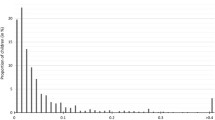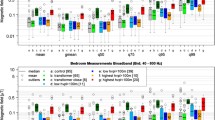Abstract
We examined the results of 1,835 magnetic field measurements in German residences conducted between November 1997 and September 1999. The measurements were part of an epidemiological study on the relationship between magnetic fields and childhood leukemia. We performed a fixed-location measurement of the magnetic field at 50 Hz and 16 2/3 Hz (frequency of the German railway system) over 24 h in the child’s bedroom in the residence of each study participant. In addition, we conducted a second 24 h-measurement in the living room at 50 Hz, and spot measurements while walking through all rooms of the respective dwelling. Median 50 Hz magnetic fields above 0.2 µT were found to be infrequent in Germany (only 1.4% of all residences). Fields produced by high-voltage power lines (123–420 kV) were lower than expected: the median magnetic field was above 0.2 µT in only 8 (32.0%) of 25 residences located 50 m or closer to a high-voltage power line indicating that power lines in Germany are usually run well below the maximum power load. We found that magnetic fields were correlated with the type of residence and higher magnetic fields were measured in apartment buildings. There was also some evidence for a positive correlation between magnetic fields and traffic density and an inverse association between magnetic fields and family net income. The 24 h-magnetic field measurements correlated well with the spot measurements (r>0.7). However, when dichotomized with a cut-off point of 0.2 µT, there was only a poor agreement between the two measurement methods. A loss of the strength of the association after categorization was also observed when comparing the arithmetic mean and median of the same 24 h-measurement. In summary, these analyses give a valuable overview of magnetic field distributions in German residences.
Similar content being viewed by others
Author information
Authors and Affiliations
Additional information
Received: 31 January 2000 / Accepted: 25 July 2000
Rights and permissions
About this article
Cite this article
Schüz, J., Grigat, JP., Störmer, B. et al. Extremely low frequency magnetic fields in residences in Germany. Distribution of measurements, comparison of two methods for assessing exposure, and predictors for the occurrence of magnetic fields above background level. Radiat Environ Biophys 39, 233–240 (2000). https://doi.org/10.1007/s004110000068
Issue Date:
DOI: https://doi.org/10.1007/s004110000068




